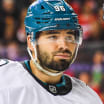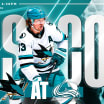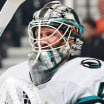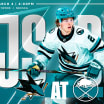Hockey in the Bay Area?
It took years to legitimize the game's roots in San Jose with the help of a sometimes forgotten franchise in the California Golden Seals, who started introducing the game of hockey to a brand new audience of people 50 years ago.
But what was it like introducing the hockey world to the Bay Area?
The San Jose Sharks boast a roster of players that have traveled to San Jose from across the United States, Canada and as far as Europe, with many of the players making their first trip to the Golden State.
With a handful of players familiar with California only from what they saw in movies or television, they quickly realized it was not the glitz and glam enterprise of Hollywood, rather it had a unique scenery of its own about 400 miles due North of Los Angeles.
"I had that picture from TV," forward Timo Meier said. "Warm weather, palm trees, beaches and those beautiful drives along the water."
A Tale of Two Teams: California Hockey, Then and Now
Coming to California wasn't necessarily on Meier's radar before he was drafted by the Sharks at the 2015 NHL Draft and the same can be said for Patrick Marleau when he came to San Jose nearly 20 years earlier.
"I had no idea where or what it was like," Marleau said. "You always hear California and you picture beaches. I thought it would be desert-like too. I really had no idea."
The same can be said nearly 20 years earlier than Marleau too.
"You could drive a corvette in shorts and a t-shirt" former Golden Seals forward Dennis Maruk laughed.
Maruk was drafted by the Golden Seals at the 1975 NHL Amateur Draft in the second round (21st overall) and played his rookie year, the Seals final season in Oakland, with the team before they closed up shop and moved to Cleveland.
"I owe a lot to the California Golden Seals for giving me a chance to do what I could do on the ice," he said. "And when you're wearing shorts and a t-shirt to practice, it's pretty special."
Despite not always being considered a "hockey haven," there was a small minority of Sharks players who were already slightly tuned into Team Teal upon their arrival.
One even wore a Sharks onesie as a toddler.
"My mom said it must have been on sale," defenseman Brenden Dillon joked.
"Teal was a very unique color," he said. "I wore that thing every day when I was either two- or three-years-old. It's a small world and pretty cool to be wearing a Sharks jersey now."
Dillon grew up in British Columbia in Western Canada and followed the rivalry that emerged between the Sharks and Vancouver Canucks when San Jose joined the league.
"The Sharks as a team, as a brand, was special," he said. "Growing up with Mike Ricci, and as I got older Joe Thornton, it was definitely a team that people knew about where I'm from."
He was not the only one either. Blueliner Brent Burns sported a Sharks jersey during a school picture and forward Tommy Wingels owned one as well.
"Everyone loved the logo and the name," Marleau said.
And if that wasn't the reason, maybe they were just "tired of the winters," like former Seals radio broadcaster, Joe Starkey.
Whatever the case, for many, California is seen as foreign territory for young hockey players - whether those players come from the first franchise in Northern California, the Golden Seals, or the Bay Area's current tenants, the Sharks.
While those first-time experiences of California seem similar regardless of what era these players surfaced from, the same couldn't be said about both team's experiences on the ice.
Sharks players all agree that San Jose has an intense fandom, but that sentiment wasn't always around when the Seals first settled at Oakland-Alameda County Coliseum Arena as an NHL franchise.
"[The Seals] were taken aback by how difficult it was to get people here to watch these games," said former Seals public relations executive Len Shapiro.
"What surprised me was your team had to be a success [on the ice] or it was, 'aw heck, let's go to the beach," former Seals radio broadcaster Joe Starkey added.
In a time where the game was making its first argument as a premier event, the Seals had some heavy competition from its neighboring teams at the backdoor of its campus.
"It was more about the Raiders and Athletics," Maruk said.
Maybe the lack of information did not help its case either.
"Education was a big part," Maruk said. "We had a weakness, because people didn't know a lot about hockey. We had to teach the fans about the game, because once they got to the game, they loved it.
"The problem was, I only got one year and then we moved to Cleveland."
Perhaps the location was to blame.
"The Seals had a shot at making it if they could make it into the city," Starkey said. "But an arena never got approved in San Francisco."
And once the attendance was so low, the Mercury News' beat reporter did his own personal head count of how many people actually showed up for the Seals' game.
While the Golden Seals could never get it exactly right 50 years ago, their impact in the area laid the groundwork for the Sharks in San Jose.
Now five decades later, the Sharks are the epitome of West Coast hockey, including drawing a record more than 70,000 fans to the outdoor Stadium Series game versus another California native, the L.A. Kings, at Levi's Stadium during the 2014-15 season.
And of course a Western Conference Championship and its first ever Stanley Cup appearance to boot.
"They really paved the way for the Sharks to come back here," Marleau said. "It was possible to build that franchise."
"What has happened is phenomenal," Starkey said.
When the team left, "nobody seemed to care. The next thing you know, the Sharks arrive."
"San Jose was the best thing that ever happened to them," he finished


















